Visualizations and crowd mapping keeps getting cooler, and with Ushahidi and Crowdmap, individuals have the open source tools to share personal experiences on their own terms. Swahili for “testimony” or “witness,” Ushahidi was developed in 2008 to help map reports of violence in Kenya after the post-election fallout. Think Kenyan citizen journalists with web and mobile phone access. Since the project started, Ushahidi has grown into a team of volunteers in Africa, Europe, South America, and the United States.
 In addition to being used to monitor political unrest, Ushahidi was deployed globally to track the Swine Flu outbreak. Users can submit reports using any device with a digital data connection, such as SMS messages, MMS, or online. Reports are posted in “near real-time” onto interactive maps, which can be viewed from a computer or smartphone.
In addition to being used to monitor political unrest, Ushahidi was deployed globally to track the Swine Flu outbreak. Users can submit reports using any device with a digital data connection, such as SMS messages, MMS, or online. Reports are posted in “near real-time” onto interactive maps, which can be viewed from a computer or smartphone.
Ushahidi Installs
The Ushahidi site includes links to pages explaining system requirements, a download option, installing and upgrading Ushahidi, Ubuntu and FreeBSD installs, and a link to instructions for installing the platform on a Dreamhost server. Mobile apps for iOS and Android are also available. All the software is free and released under the LGPL License and public repositories are on Github.
I downloaded the iOS app to my iPhone to test out the platform. A demo is included in the mobile app, or you can link to an existing map if you have the URL. Another option,
The Bedbug Mapper isn’t as cool as it sounds. It’s only one report, which is dated 2010 and marked “unverified;” however, you can see how mapping bedbugs could come in handy during a bedbug epidemic. A button in the bottom, right-hand corner of the app lets users add reports, with fields for Title, Description, Category, Date, Location, Photos, and News URL. Reports can be viewed as a list or as pins on a map.
Creating a Map with Crowdmap
Another option is Ushahidi in the cloud, which is Crowdmap. It’s no install required and only minimal configuration necessary. After creating a new account on Crowdmap, which was as easy as entering my name, a password, and map name, I used the new map URL to create a new map on my iOS app: https://trampslikeus.crowdmap.com.
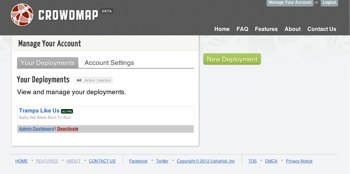
I’ve recently taken up trail running and hired a running coach, Coleen, whose business name is taken from lyrics in the Bruce Springsteen hit song “Born to Run.” Now to test out the map on the road… or trail, in this case. Before getting started with a new map, you might want to watch the Ushahidi Crowdmap 101 video.
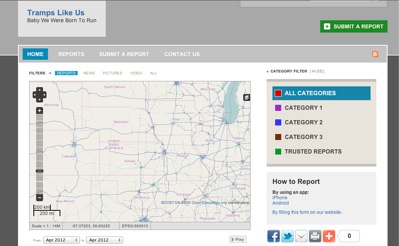
On the Site Settings page, you can name your site, add a tagline and banner, and tweak some settings to control who can submit reports and how your front end and admin pages look. The Map Settings page allows you to change the default location, which is Kenya. I changed mine to the United States.
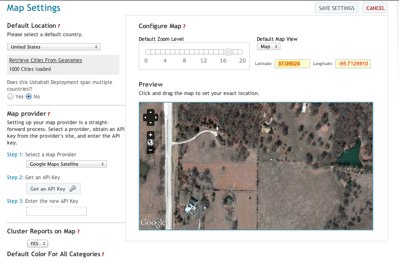
Next, choose your map provider and get an API key, then tweak some settings for how your reports will display on the map. You can also adjust settings for SMS, Email, and API. Under the Facebook settings, you can add a Facebook app, assuming you’ve created one. I skipped that part for now. The External Apps option lets you add apps; the Ushahidi iPhone and Android apps are included by default in the list, but you can remove them.
Next to Settings, there is a Manage option, which is where you edit categories, for example. I created categories for trails, organized trail runs, races, alerts, and incidents.

The Forms option lets you edit the default form fields or create a new form. I added a new drop down field to rate trails and runs from Excellent to Tragic. Other settings include Pages, News Feeds, and Layers. I selected Scheduler to adjust my Alerts and Email settings.
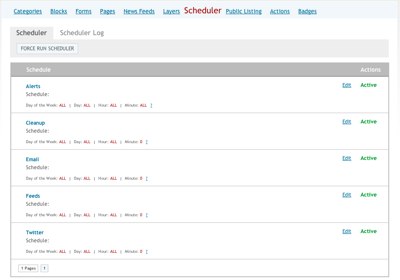
The Public Listing option lets you categorize your map; I chose Recreation. Then you can add a description and make your map publicly available.
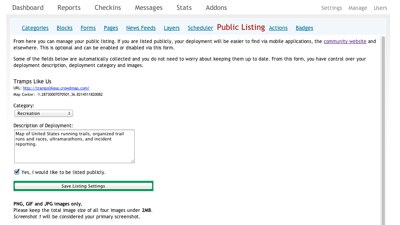
An experimental feature, Actions, lets you set a Trigger, such as Report Added or Checkin Recorded. I chose Checkin Recorded and made the Response be

The Badges option lets you pick a badge or upload your own badge. I’ll revise this option later with badges for race medals, running club logos, and scenic routes.

Next, I selected a Theme and chose one that was geared toward check ins. Finally, I added an About page with some information to explain the point of Tramps Like Us.

With my iPhone in hand, and prior to tweaking all the admin settings I just described, I decided to add a real report to my Tramps Like Us map to describe my Thursday night group trail run. I took a photo of my fellow runners, added the title and description for my report, and the date and time were automatically added by the iPhone app. Because I hadn’t adjusted all my admin settings before my evening run, I assume that is why I got an upload error message, and another, and another. Later I tried adding my report from my laptop, and then I got a new error, which I reported to the developers.
After logging into the Crowdmap admin page for Tramps Like Us, I saw my 10 reports, which were waiting approval. So, despite my upload error messages, my reports had actually been uploaded. In hindsight, adjusting all of the admin settings before running in the woods with the Lawrence Trail Hawks would have been a better idea.
I’m still playing around with Crowdmap and my Tramps Like Us map. My fellow runners were intrigued when I told them about the app, so I expect we’ll use this for a while and see how we like it. There are also plenty of other maps out there to explore and plugins and tips to try. Overall, Ushahidi and Crowdmap seem to be flying below the radar and not getting the attention they deserve from the open source community, citizen journalists, activists, and those of us who are always looking for a fun new way to blend our online worlds, mobile devices, personal experiences, and real-world surroundings.
If you are using Ushahidi or Crowdmap, or you start using it, let us know about your experiences in the comments and tell us about your map and reports.





